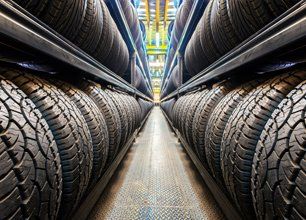The Science Behind Tire Fixing and Security
When it concerns the complex world of tire upkeep and safety and security, there exists a realm of science that frequently stays hidden by the average motorist - discount tires morris il. The materials that make up a tire, the impact of tire pressure on total security, the effects of walk wear, the intricate characteristics of tire grip, and the often-overlooked value of appropriate wheel placement all play crucial duties in guaranteeing a vehicle runs safely and efficiently. As we browse via the intricacies of tire repair service and security, it ends up being evident that a much deeper understanding of these clinical principles is not just beneficial yet necessary for every single chauffeur when driving
Tire Structure and Functionality
What materials make up the structure of tires, and exactly how do these components contribute to their performance on the road? Steel cords are incorporated to boost the tire's strength and aid it preserve its form under different roadway problems.
The rubber compounds offer grasp and traction, allowing the tire to adhere to the roadway surface area and supply stability throughout acceleration, braking, and cornering. On the whole, the cautious selection and mix of these materials make sure that tires can perform effectively and safely on numerous road surface areas and conditions.
Influence of Tire Stress on Safety And Security
Maintaining appropriate tire pressure is necessary for guaranteeing optimum safety and efficiency while driving. The impact of tire pressure on safety and security can not be overstated. Underinflated tires are vulnerable to getting too hot, which can cause tire blowouts, specifically at broadband. Additionally, low tire stress influences the handling and responsiveness of the vehicle, boosting the risk of accidents, particularly during emergency situation maneuvers. On the other hand, overinflated tires have much less call with the roadway surface, minimizing grip and creating uneven endure the tire footsteps. This compromises the vehicle's security and braking performance, posing a considerable safety and security danger. Appropriately filled with air tires also play an essential function in fuel efficiency, as underinflated tires can boost moving resistance, causing lowered gas mileage. Routinely checking and keeping the correct tire pressure not just ensures security but likewise prolongs the life expectancy of the tires, minimizing replacement prices over time.
Footstep Use and Its Ramifications
Appropriate surveillance of tire walk wear is vital for guaranteeing optimal performance and security on the road. As tires put on down, the depth of the tread lessens, minimizing the tire's capability to maintain traction, especially in damp or slippery conditions. The walk pattern and depth play an essential function in channeling water far from the tire to stop hydroplaning and keeping hold when traveling surface area.
Indications of excessive step wear consist of bald places, irregular wear, and the appearance of wear signs. Hairless spots suggest local wear, which can result in instability and raised risk of blowouts. Unequal wear might suggest problems with tire rising cost of living, suspension, or alignment elements. Wear signs are constructed right into the tire tread and become noticeable when the tread deepness reaches a specific nadir, suggesting the demand for immediate replacement.

Understanding Tire Traction Characteristics
Monitoring tire step wear not just guarantees optimal efficiency and security but also directly affects the traction dynamics of the tires on different road surface areas. Tire traction is a crucial facet of lorry handling and security, as it figures out the hold in between the tires and the road. Grip characteristics vary depending on roadway problems such as completely dry pavement, wet roadways, snow, or ice.

Understanding tire grip dynamics is important for vehicle drivers to adapt their driving behavior according to the road problems. morris tire service. Regularly inspecting tire step deepness and problem can significantly boost grip performance, making sure much safer driving experiences across numerous surface areas
Value of Appropriate Wheel Placement
Making sure right wheel placement plays an essential role in enhancing lorry performance and expanding tire longevity. Appropriate wheel placement includes readjusting the angles of the wheels to producer specifications, guaranteeing that they are perpendicular to the ground and parallel to each other. When alignment is off, it can result in unequal tire wear, reduced gas performance, and jeopardized handling.
One of morris tire the vital advantages of maintaining appropriate wheel positioning is improved taking care of and stability. Misaligned wheels can create the lorry to draw to one side, impacting guiding control and overall driving experience. Furthermore, right placement promotes even tire wear, avoiding early tire substitute and conserving on upkeep prices over time.

Final Thought
In final thought, the scientific research behind tire repair service and safety is important for maintaining lorry efficiency and ensuring vehicle driver security. By recognizing tire make-up, pressure, tread wear, grip dynamics, and wheel placement, motorists can prevent crashes and prolong the lifespan of their tires. Proper upkeep and regular assessments are necessary for optimal tire efficiency and total lorry security. By adhering to these standards, drivers can drive confidently understanding that their tires remain in excellent condition.
The materials that make up a tire, the impact of tire pressure on total safety, the ramifications of tread wear, the detailed dynamics of tire traction, and the often-overlooked significance of correct wheel alignment all play important functions in ensuring a car operates securely and efficiently. On the other hand, overinflated tires have much less call with the road surface, decreasing traction and creating irregular wear on the tire treads. Regularly checking and maintaining the right tire stress not just makes sure safety yet additionally expands the life expectancy of the tires, conserving on substitute prices in the long run.
Keeping track of tire tread wear not only guarantees optimum efficiency and security however also straight influences the traction dynamics of the tires on different roadway surface areas. Tire traction is a crucial aspect of vehicle handling and security, as it figures out the hold in between the tires and the road.